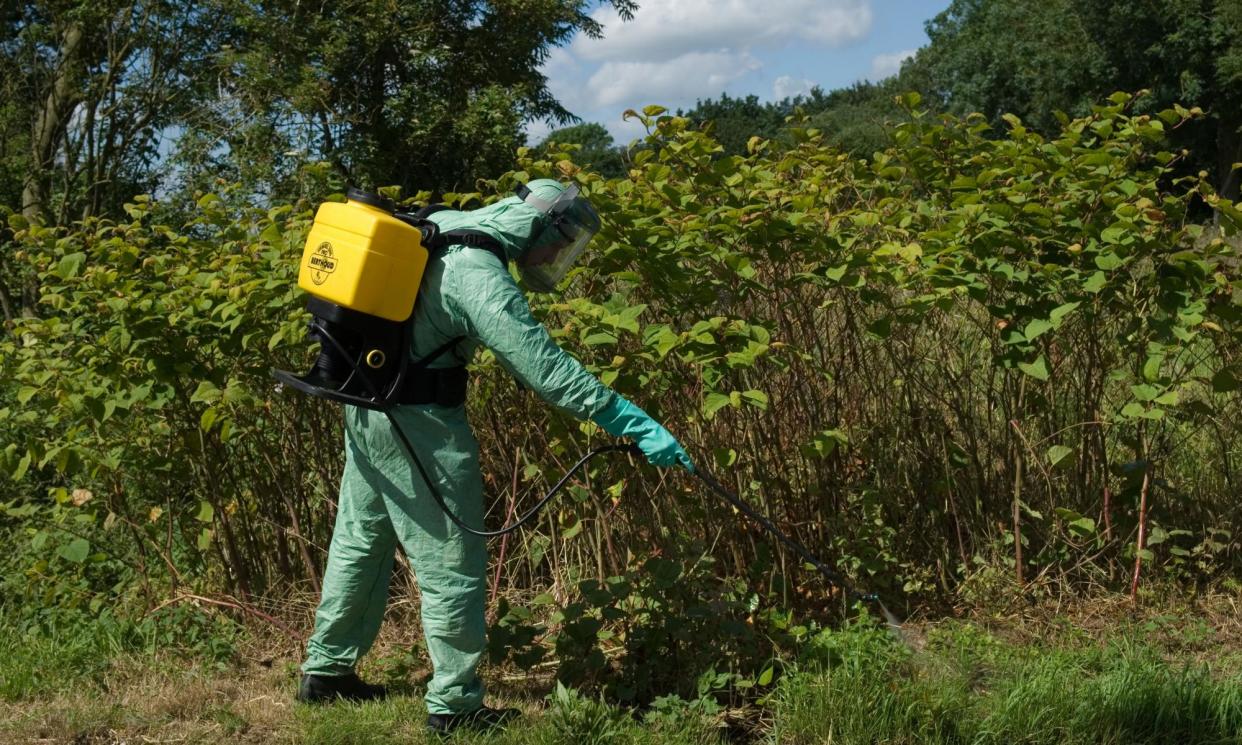UK homeowners warned as climate crisis turbocharges knotweed menace

Homeowners are being urged to be extra vigilant of Japanese knotweed growing on their properties after the invasive species emerged six weeks earlier than usual this year following unusually warm weather.
The distinctive red stems were spotted throughout February and March, a development which has been linked to climate change.
Hundreds of millions of pounds are spent tackling the spread of the extremely resilient plant every year. Homeowners can be hit with large bills for its treatment, which can last for a number of years, and the value of a property, or its potential for sale, can also be affected.
England and Wales had their warmest February on record this year, with mild and wet conditions common.
The Property Care Association (PCA), a trade body of building professionals, reported that this allowed the plant to thrive, and that stems had been spotted well ahead of the start of the usual growing season in April.
Ben Lindley, of Japanese Knotweed, a specialist in tackling the plant, says it tends to appear from its winter hibernation earlier in warmer weather.
He says: “We are seeing quite a lot of it everywhere, from as early as February and through March … a good month, or month-and-a-half, earlier than normal.”
Growing fears
The prospect of the plant growing on a property can strike panic in homeowners due to its potential to damage driveways and patios, hinder surrounding plants from growing and spread rapidly – as well as the expense of getting rid of it.
Originally introduced in the mid-19th century as an ornamental garden plant, it costs the economy almost £250m a year to tackle as it grows on roadsides, riverbanks and derelict land. It is extremely resilient, and able to grow in a range of different types of soil.
“In a mini-ecosystem setting, if it is able to emerge earlier than surrounding native plants, it can shroud them in shade, making it harder for them to compete,” says Lindley.
The red and green shoots can grow rapidly – by as much as five inches in a day, he says. Within the space of four weeks, they can reach more than a metre in height.
But what is above ground is just one part of the problem. While there could be one square metre of stems visible, below ground can be five square metres of underground stems called rhizomes.
These can spread out from the plant, allowing it to go from one property to another if not controlled, says Lindley. “That’s what you don’t want to disturb. If you do disturb that, it will instantly promote more growth in that area.
“Somebody with knotweed will have a significant area of their property which they can’t do much with,” he says.
Effects
Anyone selling their property has to declare on a form whether or not the species is present. Answering untruthfully can result in legal implications, as can allowing it to spread to neighbouring properties without treatment.
In 2019, a court awarded a homeowner £50,000 in damages from his surveyor after he had to pay £10,000 to clear the problem. The court ruled that his ability to use the land his house was on was hindered by the plant.
Now that it is appearing earlier in the year, homeowners have been told to be especially vigilant. Daniel Docking, of the PCA’s invasive weed control group, says people who spot it should seek help quickly in order to manage the problem.
“Japanese knotweed is tied to legislation, which means landowners have a responsibility to manage infestations responsibly,” he says.
Treating the problem
Getting rid of knotweed, however, can be a lengthy and costly process. The simplest way is to apply herbicide over a long time. It can take between two and three years of treatment to stop the plants from regrowing, says Lindley. Such a plan of action usually costs between £2,000 and £3,000.
It can be instantly eradicated by excavation, but costs can spiral to between £5,000 and £15,000, with terraced houses typically proving even more expensive because of the difficulty in getting the necessary equipment in.
The Property Ombudsman, the dispute service, says sales can fall through because of the plant.
“Just as sellers have an obligation to disclose the presence of knotweed during contract enquiries, estate agents have an obligation, under consumer protection regulations, to advise buyers of any material facts that would affect their decision to buy,” it says.
When selling a property affected by growth of the weed, the buyer and mortgage lender will want to see a management plan, says Lindley.
Homebuyer let down by the law
Buying a property without knowing that Japanese knotweed is present can result in frustrating legal problems.
Jonathan Rolande, a property investor, bought a house in Wales after a surveyor reported that there was none present.
But a subsequent inspection found it in the back garden of the mid-terraced home, and legal attempts to claim the money “fizzled out” after the cost of pursuing it became too much.
“We went back to the surveyors and got absolutely nowhere. They didn’t want to know. They denied all responsibility, despite the box being ticked to say ‘no’.
“So we ended up just having to swallow the cost of the works to put it right, which has taken about two or three years,” he says.
“Normally the surveyor would be liable if they’ve ticked a ‘no’, and in my experience, that didn’t protect us, either.”
The treatment ended up costing him some £3,000.


